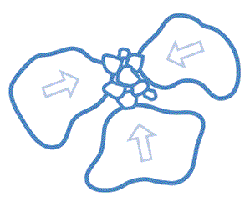Sea ice cycle: chapter 3
Deformation
Besides growing, the ice pack can also alter its shape and dimension. The movement of winds and currents is one obvious cause of ice deformation. Another one is the thermal expansion and contraction of the ice.
Expansion and contraction of sea ice
As the temperature of sea ice falls below its freezing point, the ice expands rapidly at first, and continues to expand but at a decreasing rate until a certain temperature is reached, after which it contracts slightly. The greater the salt content (salinity) of the ice, the greater the expansion with cooling.
As a result of this thermal expansion, we have pressure ridges forming on the ice surface at first; later on, when temperatures are lower and the ice begins to contract, cracks will form. The cracks are narrow because the contraction is much less than the expansion.
As the ice warms up, the ice first expands slightly, closing any cracks, then contracts again and at an ever-increasing rate as its melting point is reached. Thus, during a mild spell or after the beginning of the thawing period, wide cracks will be found in the ice.
Deformation Features of Sea Ice
Pressure Ridges

Pressure ridges can be formed in two ways:
- from the pressure exerted on the ice by the force of wind or tide;
- from thermal expansion.
Pressure ridges occur mostly in newer ice. Since newer ice is the most salty and flexible of ice types, the pressure ridges are relatively weak in strength when newly formed. They are a navigational hazard because of their thickness, rather than their strength.
It has been found that pressure ridges extend downward 4 to 5 times as far as they extend upward. Ordinarily, sea ice, because of its density, floats with about 5 times the thickness below the surface as above. A newly formed pressure ridge does not have this 5 to 1 ratio, and so is unbalanced. It must sink gradually to restore equilibrium. Consequently, pressure ridges are highest when first formed.
Hummocks

Hummocks are small hills of broken ice which has been forced upwards by pressure. They may be fresh or weathered. The weathering may occur when drifted snow piles up against a pressure ridge and is partially melted and compacted into a solid mass. Or, it may occur because of summer thawing and solar radiation.
Hummocks are less salty (almost fresh) than pressure ridges and are much stronger per unit of thickness. The melting point of the hummock is near 0°C while pressure ridges begin to melt at a lower temperature. Thus, hummocks are always the last type of sea ice to melt.
Ice Floes

Ice floes are formed by the cracking and breaking of a solid ice sheet.
Rafting

Rafting occurs when two floes are pressed together in such a way that one over-ridges the other in a continuous manner. The thickness is obviously doubled where the rafting occurs but there is a minimum of fracturing of the floes. Rafting is most common in the thinner forms of ice where the vertical motion required is low.
Cracks

Cracks are formed where an ice sheet breaks and the floes separate. In low temperatures they refreeze quickly and may subsequently be forms of ridging.